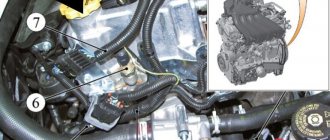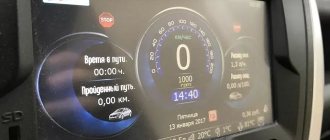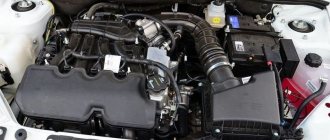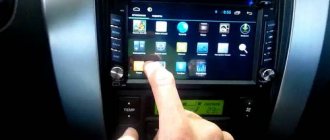One way to squeeze a little more driving fun out of your car is to seek chip tuning services. They say that flashing the electronic engine control unit (ECU) makes the car more dynamic, reduces acceleration time to 100 km/h, makes the accelerator pedal more responsive, etc. Feature of Vesta and XRAY.
The plant installs the same 1.6-liter VAZ 21129 and 1.8-liter VAZ 21179 engines in Lada Vesta, Vesta SW, Vesta cross and XRAY cars, so it was decided to combine the reviews in one article.
Earlier, one of the masters of his craft answered all the basic questions about engine firmware.
Chip tuning is usually completed within 20 minutes:
- The master is connected to the ECU connector in the engine compartment (in the passenger compartment, the OBD-II connector is not suitable for this; there is no registration protocol).
- Reads the standard program (so that everything can be returned if necessary).
- Compile a modified version of the program.
The approximate price of chip tuning is 2500 rubles. Let's see if this engine tuning is worth the money?
RSW. One of the first reviews about Vesta chip tuning appeared in the summer. In it, the author states that after updating the “brains,” Vesta began to accelerate to hundreds almost 2 seconds faster (the time decreased from 16.2 seconds to 14.4). According to him, chip tuning changed the response of the accelerator pedal and slightly loosened the clamp of the stabilization system (it became possible to start with a slight slip). At the end of the video review, he shares his impressions of chip tuning:
- the accelerator pedal reacts more sharply to movement, there is no delay when you need to accelerate;
- when driving, the stabilization system works much later.
Bottom line: Chip tuning is worth the money. You shouldn't expect a miracle, but you will definitely get a little pleasure.
Another review appeared soon after. The Vesta owner first took readings using Racelogic in the standard configuration, and then loaded the RSW firmware. I took the values using the same software and compared the two graphs.
The only change that was noticed is that the throttle valve opens completely, somewhere in the middle of the stroke, there is no point in pressing further, nothing changes. In other words, only the accelerator pedal was stitched.
Icebreaker. In a similar way (using Racelogic), a comparison was made between the standard and modified versions of the ECU program. According to estimates, Vesta first accelerated to 100 km/h in 219.45 meters, and after tuning the chip, the car traveled 229.47 meters in the same time. If you imagine this visually, the chip machine was two bodies ahead. It was also noted that in first gear the engine can be “scranked” to 7000 rpm and above.
There are also firmwares for the Vesta engine with the names “Paulus” and “Adakt”. Reviews about them will be added over time.
Do you think it is possible to achieve a significant increase in power by tuning the microcircuit, or is there no point in flashing a naturally aspirated engine? Leave your feedback about Vesta / XRAY chip tuning in the comments. Let's remember that we previously looked at the optimization of Grant, Kalina and Priora microcircuits.
- Engines
- Ns
- 21129
The 1.6-liter 16-valve VAZ 21129 engine was first introduced only in 2015 and is essentially an adaptation of the 21127 unit to the stringent environmental requirements of EURO 5. This engine was created for the Lada Vesta and X-ray models, and has been installed on Largus since 2022 of the year.
The VAZ 16V line also includes: 11194, 21124, 21126, 21127, 21128 and 21179.
- Characteristics
- Description
- Consumption
- Application
- Reviews
- Service
- Break up
- Prices
What is chip tuning
The phrase “chip tuning” is formed from two words: “chip” - microcircuit, and “tuning” - improvement. The essence of the process is to change the engine control algorithms of the electronic unit to achieve better results - finalizing the factory characteristics. The ECU operates according to a specific program, which is stored in a ROM type memory (read-only memory), in accordance with various calibration tables (two- or three-dimensional). There are calibrations for different engine operating modes - starting, idling, power - and are used depending on how exactly the engine operates at a particular moment. Sensors transmit data to the controller, and it issues commands to the executive units, ensuring and maintaining stable engine operation. When adjustments are made to the calibration tables, the operating algorithm of any unit controlled by the ECU changes.
To increase power, you can change the ignition timing, fuel injection time, and the operating mode of the catalyst responsible for the toxicity of exhaust gases. You can also increase the maximum speed and many other parameters.
Chip tuning is firmware that improves the functionality of a car. It allows you to install additional electronic modules, including replacing the standard ECU with a modernized one, followed by adjusting the operating parameters of the power plant. In most cases, chip tuning involves manipulation of the factory controller.
Advantages
The Largus engine has a reserve of power and does not work at full capacity. Controller firmware will help:
- make driving easier by improving speed and traction characteristics;
- reduce acceleration time - the car will accelerate faster;
- increase engine power, which will allow you to feel almost no failures when the air conditioner is operating or at maximum load: lack of power from the factory is the main factor in the use of chip tuning.
Such tuning is simpler than a deep modernization of the engine - installing a turbine or boosting it. Installing the firmware takes no more than an hour, while the work listed above can take a week or more. Among the advantages of such modernization:
- chip tuning is an inexpensive procedure and at the same time effective;
- if the firmware is unsuccessful, you can return the engine operating mode to factory settings;
- high availability of such adjustments;
- chip tuning helps adapt the operation of the power unit to a different type of fuel - important when installing gas equipment;
- the ability to configure the internal combustion engine for changes made to the design - turning off the catalyst, cutting off maximum speed and engine speed values, removing filters.
The settings are selected according to your driving style - from economical to aggressive. Combined software has become in demand, with the help of which maximum results can be achieved from the engine.
After the firmware, there is a general improvement in performance and an increase in performance relative to the standard version by about 20%.
Flaws
Chip tuning has fewer disadvantages than advantages, but each of them can “discourage” the desire of car enthusiasts to flash the ECU. Negative aspects of the procedure:
- complete or partial failure of the engine when using incorrect firmware, during self-installation or when contacting incompetent specialists;
- reduction in engine life - indicators are insignificant, about 4%;
- incorrect setting can lead to increased fuel consumption;
- radical chip tuning with serious changes in the operation of the internal combustion engine is an expensive undertaking.
Engine firmware, great review from the master
What does the firmware of the engine control unit (ECU) affect?
If I replace the factory firmware, what are the pros and cons? Which firmware is better? These and other questions were answered on the Lada.Online website by a specialist who has been involved in chip tuning of cars, including LADA models, for about 15 years. Stanislav Polyakov began to work on engine firmware since the days of the VAZ 2114, Prior and Kalin cars. For more than 10 years he has been working in a specialized center for repairing Mercedes-Benz commercial vehicles. Engaged in repairs and flashing of Mercedes-Benz trucks and Sprinter vans. Now he is actively involved in chip tuning of modern Lada Vesta, Lada XRAY and Lada Granta cars. Total experience working with firmware is more than 15 years.
Question
: What does engine firmware provide or, as they say, the “brains” of a car?
Answer
: Chip tuning allows you to reveal the potential of the engine more fully. In this case, ecology fades into the background, and in the first place are the power characteristics, which make it possible to achieve better torque, elasticity, power, etc. Also, firmware can solve the problem of long engine startup, change the temperature at which the fan turns on, solve problems with jerking when shifting gears, familiar to many Vestavods, problems with the immobilizer, etc.
Question
: Really, I can’t make normal firmware at the factory?
Answer
: At the factory, engineers make firmware that must meet toxicity standards. Therefore, the factory firmware suffocates the engine for the environment.
Question
: Where did the firmware names of MMK, Chelyaba, Icebreaker, Paulus, RSW, etc. come from?
Answer
: Tuning authors take factory firmware and make their own based on it, calling it according to their brand.
Question
: Does the engine power change after the firmware?
Answer
: Power after engine firmware is most often not measured, and even if it is measured, the test bench readings are not an indicator of the quality of the firmware. A car with firmware can drive much better than a factory one, the pedal will be more responsive, it will respond faster to the gas, it will accelerate faster, but the power may remain approximately the same or slightly more than the factory one (as for naturally aspirated engines).
There are firmwares that show amazing results on a dyno, but in fact the car doesn’t drive at all. The car just jerks and detonates, it is impossible to drive with such firmware. In my practice, many people bought such firmware and then gave up. I have it too, I tried to install it, the car doesn’t drive on it at all, it sometimes breaks out from under itself, or on the contrary, power loss begins. Therefore, measuring power after flashing the engine is not entirely correct; the stand measures power within one gear and with the pedal constantly pressed to the floor, but in life we don’t drive like that.
Question
: Does firmware affect engine life?
Answer
: In general, no, but if it is unsuccessful and the car detonates on it, then of course this will greatly reduce the service life, or even kill the engine.
Question
: Will fuel consumption change after the firmware?
Answer
: Consumption depends on the author of the firmware and the driver’s driving style. For most, consumption decreases.
Question
: Which firmware is better to choose? What advice can you give?
Answer
: For those who do not have an aggressive driving style and who want to get rid of dips when switching, who want to get an adequate gas pedal, but will not drive like crazy, this is how I upload firmware from MMK. These are very balanced firmwares, the golden mean between smoothness and dynamics. It doesn’t happen that after flashing the car the car drives like crazy, and at the same time it would be smooth. That is, these are things that are incompatible with each other.
MMK Super Dynamic is available for 1.6 engines with manual transmission. It allows you to get maximum dynamics from the car. Firmwares are suitable for those who like to drive. These firmwares have amazing traction, the car drives very well, but the transition from engine braking to acceleration mode is very abrupt. If you upload this firmware to someone who doesn’t like to drive, there will often be complaints about a very harsh pedal, and the ride becomes uncomfortable.
Recently I have been uploading firmware from Chelyaba to 1.6 engines with AMT (“robot”). He made firmware for Vesta with creeping mode. At the factory, 1.6-liter engines are not equipped with creep mode firmware, because the engine does not know how to accelerate. This was done at the software level, and as I understand it, they don’t want to pay money for the development of completely new software for 1.6 engines, so they decided to leave these engines without creep mode. And in the Chelyab firmware the idle speed has been slightly added to make it easier to get underway. And when the clutch is released, the “robot” accelerates a little. The car with this firmware drives very cheerfully.
Technical characteristics of Lada Largus engines
| RENAULT, K4M | RENAULT, K7M | |
| Injection type | Electronically controlled multipoint fuel injection | |
| Fuel type | Gasoline Premium-95 GOST 51105-97 | |
| Number and arrangement of cylinders | 4, in-line | |
| Number of valves | 16 | 8 |
| Cylinder operating order | 1-3-4-2 | |
| Direction of rotation of the crankshaft (camshaft drive side) | ||
| right | ||
| Cylinder diameter/piston stroke, mm | 79,5×80,5 | |
| Working volume, cm 3 | 1598 | |
| Compression ratio | 9,8 | 9,5 |
| Toxicity standards | Euro 4 | |
| Power at 5500 rpm, kW (hp) | – | 62 (84) |
| Power at 5750 rpm, kW (hp) | 77 (105) | – |
| Maximum torque, N.m (at rpm) | 148 (3750) | 124 (3000) |
| Volume of oil poured into the engine lubrication system, including oil filter, l | 4,8 | 3,3 |
Technical characteristics of the VAZ 21129 1.6 16kl engine
| View | online |
| Number of cylinders | 4 |
| Number of valves | 16 |
| Exact volume | 1596 cm³ |
| Cylinder diameter | 82 mm |
| Piston stroke | 75.6 mm |
| Power supply system | injector |
| Power | 106 hp |
| Pair | 148 nm |
| Compression Ratio | 10,5 — 11 |
| Type of fuel | AI-92 |
| Environmental standards | 5 EURO |
DIY chip tuning
The cost of updating the Lada Largus ECU software when contacting a specialized organization will be several thousand rubles. But car enthusiasts want to save money, so they are thinking about carrying out this procedure themselves. You can study the entire tuning process in detail, contact the experts, trust the chip box, or purchase all the necessary equipment and ready-made software from a specialized store.
Chip box
Installing a chip box is the simplest option that does not require time or large financial investments. The method is also suitable for beginners. It will be enough to figure out what type of engine is under the hood and buy the appropriate box. The device is inserted into the diagnostic connector, then all adjustments are made automatically. The procedure is fast, simple and straightforward. When the device is disconnected, the ECU returns to standard settings without any consequences.
Manual firmware
Compared to a chip box, which negatively affects the life of the internal combustion engine and other systems, flashing the chip is more effective. This is due to the fact that the process involves calibrating the operation of the controller, and does not replace signals to actuators. The controller firmware helps increase the power of the power unit and stabilizes idle speed when the air conditioner is running.
Chip tuning in a car service
The chip tuning process in specialized organizations looks approximately the same. The car owner comes to the service center, where, using special equipment, the factory firmware is read from the control unit. It is then modified depending on the client’s wishes - to reduce fuel consumption, increase power, remove the speed limit. After this, the ECU is flashed with a modified program.
Often, such services already have a set of programs for different cars - in this case, the duration of the procedure is reduced. After installing the new software, the warranty period begins, during which you need to run the car in. During this time, the client may demand to correct one or another parameter that made the operation worse, or to return the money for “chipping” if the result is not satisfactory. In this case, the service is obliged to “roll back” the firmware to its factory state.
Program tuning is one of the most difficult chip tuning procedures. The complexity depends on the wishes of the driver and the system that controls the engine. Tuning consists of making changes to the existing calibrations, after which checksums are calculated. If there are already similar calibrations in the database, they will be exported to the program. These procedures are carried out without the participation of the car owner. On average, chip tuning of a Lada Largus will cost about 4-5 thousand rubles.
Lada Largus chip tuning news
07/17/2019.
Chip tuning of Lada Largus with VAZ 8V and 16V engines, with M86 control unit. The firmware optimizes the dynamics in all modes (powerful pick-up from low speeds), improves the response to changes in the throttle position (the dip during sharp acceleration has been removed, greater elasticity has been achieved), and the influence of the switched on air conditioner on engine operation has been minimized. Versions with disabled lambda probe and catalyst are available. Calibration of BAV(C) ADACT firmware. 03/13/2017. Chip tuning of Lada Largus with Siemens Continental EMS3120 control unit.
02.10.2016. Firmware update for chip tuning Lada Largus EMS3132-34 from Paulusa. The newer versions are a little more dynamic than the old ones, with improved launch. Versions with disabled immobilizer are available.
06/30/2012. Lada Largus firmware from Paulus, Startpower 2012 firmware. As always, Euro 2 programs for removing the catalyst.
Our address: Moscow, Vereyskaya street 13. +7 (903) 115-11-88 +7 (926) 758-99-11 Daily from 8-00 to 22-00.
All work by appointment. ©SVD CHIP Moscow. Reproduction of materials without permission is prohibited.
About the domestic VAZ 11189 engine
In April 2022, AvtoVAZ began installing domestic VAZ 11189 engines on Largus. The advantages of this engine are described in one of the issues of “Okay Mechanics”.
| Some measurement results Autoreview | |||
| Options | Cars | ||
| Lada Largus (VAZ engine) | Lada Largus (Renault engine) | ||
| Maximum speed, km/h | 157,1/156,7* | 168,0/167,6 | |
| Acceleration time, s | 0—50 km/h | 4,3/4,8 | 3,9/4,4 |
| 0—100 km/h | 13,9/16,8 | 12,5/14,5 | |
| 0—150 km/h | 61,1/71,6 | 38,9/43,7 | |
| on the way 400 m | 19,3/20,2 | 18,4/19,4 | |
| on the way 1000 m | 36,1/37,8 | 34,1/36,0 | |
| 60-100 km/h (III) | 8,7/10,6 | 9,3/10,6 | |
| 60-100 km/h (IV) | 12,1/15,1 | 12,8/14,1 | |
| 80-120 km/h (V) | 19,3/24,0 | 22,1/23,4 | |
| * Partial load/full load | |||
| Engine characteristics | ||
| Options | VAZ-11189 | Renault K4M |
| Volume, cm 3 | 1596 | 1598 |
| Number of valves | 8 | 16 |
| Maximum power, hp/kW/rpm | 87/64/5100 | 102/75/5750 |
| Maximum torque, Nm/rpm | 140/3800 | 145/3750 |
| Cylinder diameter/piston stroke, mm | 82,0/ 75,6 | 79,5/80,5 |
| Compression ratio | 10,3:1 | 9,8:1 |
| Injection type | distributed, electronically controlled | |
| Octane number of gasoline | at least 92 | not less than 95 |
Let us remind you that you can read about the VAZ 21129 engine here.
Key words: Lada Largus engine
Dimensions
Chassis
Fuel
Briefly about the design of the Lada 21129 16 valve engine
The need to use a EURO 5 internal combustion engine on new Lada models forced the management of AvtoVAZ to once again modernize its 1.6-liter 16-valve unit. Taking 21127 as a basis, the engineers changed the inlet, blocked the outlet, and filled it with new firmware.
Since the unit is now placed on a subframe, the mountings and oil pan have been slightly modified. Also, modifications were made for the installation of an alternative French JR5 gearbox.
Otherwise it's a good old cast iron block with a lightweight SPG from Federal Mogul. The supply type here is a regular injector, a toothed belt drive with an automatic tensioner, there are hydraulic lifters in the cylinder head, and the intake system is regulated by flaps.
Okay Mechanica spoke about new technologies in the domestic automobile industry.
- One way to squeeze a little more driving fun out of your car is to seek chip tuning services. They say that flashing the electronic engine control unit (ECU) makes the car more dynamic, reduces acceleration time to 100 km/h, makes the accelerator pedal more responsive, and so on.
We tried to collect reviews about chip tuning of Vesta and XRAY with a 1.6-liter VAZ-21129 engine.
We advise you to read our articles
The ECU firmware process takes 20 minutes:
The master is connected to the ECU connector in the engine compartment (in the passenger compartment, the OBD-II connector is not suitable for this; there is no registration protocol).
- Reads the standard program (so that everything can be returned if necessary).
- Compile the modified firmware.
The approximate price of chip tuning is 2500 rubles. Let's see if this engine tuning is worth the money?
RSW firmware. One of the first reviews about Vesta chip tuning appeared in the summer. In it, the author claims that after reflashing the “brain,” Vesta began to accelerate to hundreds almost 2 seconds faster (the time decreased from 16.2 seconds to 14.4). According to him, the firmware changed the response of the accelerator pedal and slightly loosened the clamp of the stabilization system (it became possible to start with a slight slip). At the end of the video review, he shares his impressions of the new firmware:
- the accelerator pedal reacts more sharply to movement, there is no delay when you need to accelerate;
- when driving, the stabilization system works much later.
Conclusion: the firmware is worth the money. You shouldn't expect a miracle, but you will definitely get a little pleasure.
Soon another review of the same firmware appeared. The Vesta owner first took readings using Racelogic in the standard configuration, and then loaded the RSW firmware. I took the values using the same software and compared the two graphs.
The only change that was noticed is that the throttle valve opens completely, somewhere in the middle of the stroke, there is no point in pressing further, nothing changes. In other words, only the accelerator pedal was stitched.
Icebreaker firmware. In a similar way (using Racelogic), a comparison was made between standard and modified firmware. According to estimates, Vesta first accelerated to 100 km/h in 219.45 meters, and after tuning the chip, the car traveled 229.47 meters in the same time. If you visualize it, the chip machine was two bodies ahead. It was also noted that in first gear the engine can be “scranked” to 7000 rpm and above.
Changes in engine operation after chip tuning
The increase in power on all types of engines installed on the Lada Largus does not exceed 7% on average, while fuel consumption decreases or remains the same. In fact, the firmware does not affect the operation of the engine in any way. Then why does the manufacturer initially underestimate the characteristics of the power plant? It's all about European regulations, according to which power is relegated to the background. Environmental standards are not the only reason for this, but one of the main ones. In order to comply with these standards, AvtoVAZ underestimates engine power and efficiency. But often low engine efficiency is associated with errors that chip tuning can easily eliminate by using reserve engine resources unused by the manufacturer.
Many car owners are interested in the question of the warranty status after updating. The answer is clear: after chip tuning, the car is removed from warranty. No official dealer will want to take responsibility and repair a car ruined by incorrect firmware.
Chip tuners claim that firmware programs are created based on factory ones, and the results of manipulations with the software are invisible. But the dealer will definitely see that the car’s characteristics differ from the factory standard, and warranty service will be denied.
Firmware for audio device on Lada Largus
The standard head unit on cars of this model does not look very presentable, but at the same time the functionality is complemented by a large number of possibilities. Unfortunately, despite the decent quality of the technical part, the manufacturers did not pay enough attention to the software. It's no secret that modern audio systems have a full-fledged electronic control unit, which is a kind of computer. There is a processor, devices for reading removable media, various connectors and other functionality. In addition, the standard radio is combined with the on-board computer.
On the other hand, the more complex the audio system, the greater the likelihood of failures and malfunctions. The radio installed on the Lada Largus is no exception to the rule. The software has not been properly tested, so malfunctions are not uncommon. The most common problems are the inability to recognize the file format, reproduce high-quality sound, or identify the removable storage device. Also on Largus, incorrect display of Russian fonts on the display is often encountered. As a result, instead of the usual Cyrillic alphabet, the driver sees incomprehensible symbols. It is in these cases that updating the device firmware will help solve the problem.
Reviews from car owners about the car's performance after the firmware
Alexander, Barnaul: “Those who are going to “sew” for a big increase in power don’t even have to start, since this won’t happen. Among the changes, it was noted that the engine began to gain speed faster, the “dullness” of the gas pedal disappeared, I was pleased with the update. Consumption decreased slightly - by about one liter per 100 km. It’s especially noticeable on the highway - you don’t need to put too much pressure on the gas pedal. According to the master, the increase in power was about 10%. Considering the presence of a trailer, it couldn’t come at a better time.”
Advantages of Largus engine chip tuning
- Fixed factory errors in cold start calibrations;
- Dynamics and elasticity have been improved by adjusting fuel assemblies and OZ;
- Torque is optimized throughout the entire speed range;
- Significant increase in traction at the bottom;
- The engine runs more smoothly;
- The gas pedal responds to pressure without delay.
For the driver, these changes are expressed in more comfortable driving, confident overtaking and predictable behavior of the car as a whole.










